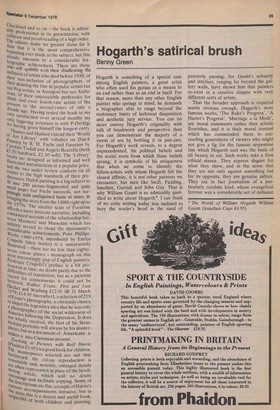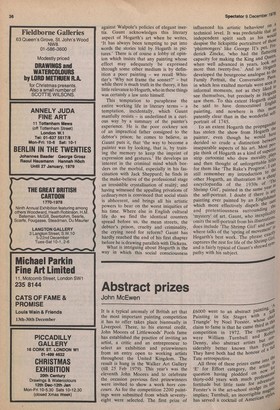Hogarth's satirical brush
Benny Green
Hogarth is something of a special case among English painters, a great artist who often used his genius as a means to an end rather than as an end in itself. For that reason, more than any other English painter who springs to mind, he demands a biographer able to range beyond the customary limits of technical disquisition and aesthetic jury service. You can no more convey Hogarth's originality with talk of brushwork and perspective than you can demonstrate the majesty of a storm at sea by bottling it in jam-jars. For -Hogarth's work reveals, to a degree unprecedented, his political beliefs and the social roots from which those beliefs sprang; it is symbolic of his uniqueness that when we come to identify the fellow-artists with whom Hogarth felt the closest affinity, it is not other painters we encounter, but men like Swift, Fielding, Smollett, Garrick and John Gay. That is why William Gaunt is so admirably qualified to write about Hogarth*. I can think of no critic writing today less inclined to bury the reader's head in the sand of painterly parsing, for Gaunt's urbanity and intellect, ranging far beyond the gallery walls, have shown him that painters co-exist in a creative climate with very different sorts of artists.
That the broader approach is required seems obvious enough. Hogarth's most famous works, 'The Rake's Progress', 'A Harlot's Progress', 'Marriage a la Mode', are moral statements rather than artistic flourishes, and it is their moral content which has commended them to succeeding generations of viewers who might not give a fig for the famous serpentine line which Hogarth said was the basis of all beauty in art. Such works take a firm ethical stance. They express disgust for what they show, and in the sense that they are not only against something but for its opposite, they are genuine satires. They are in fact journalism of a particularly resolute kind, whose evangelical fervour was a considerable act of defiance against Walpole's policies of elegant inertia. Gaunt acknowledges this literary aspect of Hogarth's art when he writes, 'It has always been tempting to put into words the stories told by Hogarth in pictures.' There is of course a lobby of opinion which insists that any painting whose effect may adequately be expressed through some other medium is by definition a poor painting — we recall Whistler's 'Why not frame the sonnet?' — but while there is much truth in the theory, it has little relevance to Hogarth, who in these things was certainly a law unto himself.
This temptation to paraphrase the entire working life in literary terms — a temptation, incidentally, which Gaunt manfully resists — is underlined in a curious way by a summary of the painter's experience. He is the poor cockney son of an impractical father consigned to the debtor's prison; he comes to believe, as Gaunt puts it, that 'the way to become a painter was by looking, that is, by training the memory to keep the imprint of expression and gestures.' He develops an interest in the criminal mind which borders on the morbid, especially in his fascination with Jack Sheppard; he finds in the make-believe of the professional stage an irresistible crystallisation of realitSr; and having witnessed the appalling privations of ordinary men is convinced that social stasis is abhorrent, and brings all his artistic powers to bear on the worst iniquities of his time. Where else in English cultural life do we find the identical counters spread before us, the mean streets, the debtor's prison, cruelty and criminality, the crying need for reform? Gaunt has hardly reached the end of his first chapter before he is drawing parallels with Dickens. What is intriguing about Hogarth is the way in which this social consciousness influenced his artistic behaviour ea a technical level. It was predictable that..t independent spirit such as his ‘410w despise ikklspe George i,s pets of , on ,ras:g derick Zincke, 'who had the flatten capacity for making the King and Queen't when well advanced in years, look more than twenty-five.' And so Hogwdeveloped the bourgeoise analogue to the Family Portrait, the Conversation neee.,,' in which less exalted mortals were seell ti; informal moments, not as they Illceurth' see themselves, but precisely as Hega.ad saw them. To this extent Hogarth e°1di be said to have democratised Elle—, painting, and nowhere is this 07. patently clear than in the wonderful se portrait of 1745. To an extent Hogarth the propagalt has stolen the show from Hogarth, 7,/e painter, even though he would aa derided so crude a distinction bet"ee inseparable aspects of his art. Most ple think of Hogarth as a kind of suPeri, nis strip cartoonist who drew moralitY and then thought of unforgettable pow' for them like 'The Rake's Progress. I the still remember my introduction t°,„4 other Hogarth, an illustration in a C11,rh—e encyclopaedia of the 1930s ef Shrimp Girl', painted in the same Yea',.nv the self-portrait. I doubt if there Is '01 painting ever painted by an English:tit which more effectively dispels the the and pretentiousness surrounding y 'mystery' of art. Gaunt, who inexellea. .0s, omits the self-portrait from his illustratP'e: does include 'The Shrimp Girl' and On, to where talks of the 'spring of moveraelltra Hogarth's best work. The phrase aarr-itt, captures the zest for life of the ShrimP and is fairly typical of Gaunt's shrewd sY pathy with his subject.















































 Previous page
Previous page